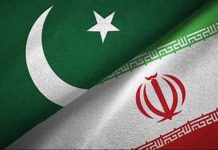“Literally a third of the country is under water,” Pakistan’s Climate Change Minister Sherry Rehman warned this week, after the death toll from the nation’s devastating floods topped 1,100 after record monsoon rains. The torrential downpours come after a series of heat waves, highlighting Pakistan’s vulnerability to climate change.
Since early June, Pakistan has been the victim of flood after flood: from the Khyber Pakhtunkhwa province in the Himalayan foothills, to the arid regions of Balochistan and Sindh in the south, riverbanks have burst and destroyed houses, roads and bridges. Thousands of people have been forced to flee their homes.
Climate Change Minister Rehman described it as a “crisis of unimaginable proportions”, telling AFP news agency that “it’s all one big ocean, there’s no dry land to pump the water out”.
According to authorities, the official death toll climbed to 1,160 on Wednesday, and some 33 million people – or one in every seven Pakistanis – are estimated to have been affected by the extreme weather that has lashed the South Asian nation in recent months. The real death toll, however, is feared to be much higher as entire areas remain inaccessible after being cut off by the floods.
On Friday, Prime Minister Shehbaz Sharif declared a national emergency, and on Tuesday, as Pakistan and the United Nations launched an appeal for $160 million in international emergency funding, he described the flooding as “the worst in the history of Pakistan”.
UN Secretary-General Antonio Guterres, meanwhile, likened it to “a monsoon on steroids” and urged the world to step up their actions against climate change.
“Let’s stop sleepwalking toward the destruction of our planet by climate change,” he said in a video message. “Today, it’s Pakistan. Tomorrow, it could be your country.”
‘An apocalypse’
Areej Aka, a spokeswoman for the humanitarian nonprofit Edhi Foundation, said that even though Pakistanis are used to monsoons and floods, “what we are witnessing this time is unprecedented. It’s an apocalypse”.
“Even the ‘super-floods’ of 2010, which killed 2,000 people, were not on this scale. [In 2010] some places stayed dry, now there is water absolutely everywhere,” she said.
The extreme weather conditions highlight how Pakistan has become trapped in a vicious circle linked to climate change.
Located at the foot of the Himalayas, the country’s rivers have become more and more swollen in recent years due to the accelerated melting of the mountain chain’s glaciers. In June, the country was then hit by heavier-than-usual rains. Although meteorologists had forecast the downpours to subside somewhat by mid-August, they instead increased in intensity, and some provinces – like Balochistan and Sindh – recorded rainfalls amounting to four times their 30-year average.
“The situation is all the more serious because these floods came after repeated heat waves between March and June. The soils haven’t had the capacity to absorb all this water,” Aka explained, pointing to the fact that for several weeks, India and Pakistan suffered extreme heat, with temperatures often exceeding 50 degrees Celsius.
On the frontline of climate change
Following Pakistan’s endless string of devastating natural disasters including floods, heat waves and forest fires, Climate Change Minister Rehman last week summed up the severity of the situation by telling AFP: “We are currently at the epicenter of the extreme weather frontline.”
For scientists, who have long warned of the imminent dangers of climate change, many of their worst fears have come true this year. And as the extreme weather phenomena are only set to increase in both numbers and intensity in the years to come, South Asia, and particularly Pakistan, is deemed to be among the first to suffer the dire consequences of climate change.
In 2020, the Bonn-based think-tank Germanwatch ranked Pakistan as the world’s eighth most vulnerable country to climate change. But in March this year, a NASA study cast an even darker cloud over Pakistan, predicting that in the not-too-distant future, some Pakistani regions will simply become uninhabitable. It pointed in particular to Jacobabad, which already ranks as the world’s hottest city. Karachi, Pakistan’s financial capital, is forecast to be submerged in seawater by 2060.
Paying the price for years of inaction
Ayesha Siddiqi, an expert on climate change in South Asia at Cambridge University, said that although Pakistan and its population of 220 million are victims of global warming, they are “also paying the price for years of delays in addressing the problem”.
Siddiqi described Pakistan’s urban planning as “chaotic”. “The country is facing strong demographic pressure. The inhabitants find themselves settling wherever they can, including on river banks, and in flood-prone areas,” she told FRANCE 24. “There are also many cases of corruption. Sometimes it only takes a few bucks to get permission to build in flood-prone zones.”
She added that some poor and remote areas, such as Balochistan, are still lacking the necessary infrastructure. “Nothing is in place to protect buildings or roads from the elements. A house made of sheet metal will be destroyed in the first flood that comes along.”
She also pointed to the country’s “poor management” of the country’s water resources, saying they have long been subject of political, rather than scientific, will, “sometimes going against all logic”.
“We are paying the price for that today,” she said.
In April this year, however, Pakistan seemed to be taking a step in the right direction as then-prime minister Imran Khan announced a massive program to fight climate change. The package included investments in renewable energy, the planting of trees and, in a highly symbolic move, the appointment of a climate change minister. After Khan was ousted from office a few weeks later, however, most of the plans seem to have been shelved.
‘Headed straight for a food crisis’
The flooding, which is estimated to cost Pakistan $10 billion in damaged infrastructure alone, couldn’t come at a worse time for the country, which is already suffering a severe economic crisis.
“We are on the verge of a humanitarian crisis,” Aka said. “The flooding has destroyed wheat and rice fields that were ready to be harvested.”
Authorities estimate that some 80,000 hectares of Pakistani farmland have been destroyed so far, and those that have been flooded are not expected to be able to produce anything for at least another season.
“On the markets, prices are already rising. The price of tomatoes and onions, for example, has increased fourfold. We are heading straight for a food crisis,” Aka said.
But there are other problems linked to the floods too: the spread of diseases. “Mosquitoes are proliferating everywhere in the stagnant water, raising fears of malaria.
Not to mention the lack of drinking water,” she said, noting that her NGO has deployed both helicopters and boats in a bid to rescue stranded Pakistanis and to hand out emergency aid kits to those that stay put. But some areas remain inaccessible.
In addition to the UN’s emergency appeal, the International Monetary Fund (IMF) this week announced it would unblock $1.17 billion for Pakistan as part of a $6 billion bailout deal agreed on in 2019, but which had been temporarily put on hold due to concerns over Pakistan’s compliance with the deal.
But, Siddiqi, noted, after the worst of the emergency has been responded to “comes the time for reconstruction.”
“And then the government will have to rebuild in a sustainable way, taking into account the reality of global warming.”

















